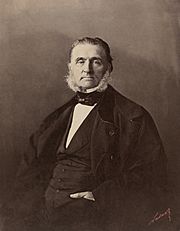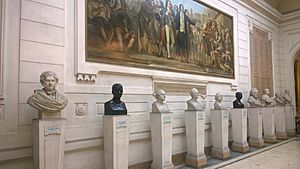Armand Trousseau facts for kids
Quick facts for kids
Armand Trousseau
|
|
|---|---|

Armand Trousseau.
|
|
| Born | 14 October 1801 Tours, Indre-et-Loire, France
|
| Died | 23 June 1867 (aged 65) Paris, France
|
| Occupation | Physician, Internist |
| Known for | Trousseau sign of malignancy, Trousseau sign of latent tetany, Trousseau-Lallemand bodies |
| Children | Georges Phillipe Trousseau |
Armand Trousseau (born October 14, 1801 – died June 23, 1867) was an important French doctor. He was an internist, which means he specialized in treating adult diseases. Dr. Trousseau made many important discoveries in medicine. Some of these are named after him, like the Trousseau sign of malignancy and the Trousseau sign of latent tetany. He also helped us understand more about certain proteins in the body.
Contents
Life and Early Career
Armand Trousseau was born in Tours, France. He began studying medicine in his hometown. His teacher was a famous doctor named Pierre Bretonneau. Later, Trousseau moved to Paris to continue his studies. He earned his doctorate degree in 1825.
In 1828, the French government asked him to investigate serious diseases. These diseases were spreading in southern France. After this, Trousseau went to Gibraltar. He was part of a group studying yellow fever. His early work helped him become known in Paris.
Becoming a Leading Doctor
In 1830, Trousseau became a hospital doctor. He worked at the Hôtel-Dieu hospital. He also took on public health roles. In 1837, he won a major award from the French Academy of Medicine.
He became a doctor at Hôpital St. Antoine in 1839. Later, he became a professor in Paris. He taught about therapy and medicines. In 1850, he became a professor of clinical medicine. He returned to work at the Hôtel-Dieu hospital.
Politics and Health
Trousseau was also involved in politics. This was especially true after the French Revolution of 1848. He held several important positions. He was even a member of the legislative body.
In his later years, Dr. Trousseau became ill. He developed gastric cancer, which is stomach cancer. It's interesting because he had previously described the Trousseau sign of malignancy. This sign is sometimes seen in people with cancer. He noticed a similar sign in himself. This illness made it hard for him to work. Sadly, it was the cause of his death.
His Medical Legacy
Trousseau helped create new ways to treat many illnesses. These included croup, emphysema, and malaria. He won an award for his important essay on laryngology. This is the study of the voice box.
He was the first doctor in France to perform a tracheotomy. This is a surgery to create an opening in the windpipe. He wrote a book about this procedure. He also wrote about intubation in 1851. His medical textbooks were very popular. They were even translated into English.
New Medical Terms
Trousseau also created new medical terms. He came up with the word aphasia. This term describes difficulty with language. He also popularized the use of eponyms. Eponyms are names of diseases or signs named after people. Examples include Addison's disease and Hodgkin's lymphoma.
In 1833, Trousseau invented a special tool. It was called the Trousseau Tracheal Dilator. This tool helped doctors perform tracheostomies more easily.
A Great Teacher
Many people thought Trousseau was an amazing teacher. Several of his students became famous doctors themselves. One of them was Ramón Emeterio Betances. He was a surgeon and a leader from Puerto Rico. Trousseau's son, Georges Phillipe Trousseau, also became a doctor. He was even the royal doctor for the Kingdom of Hawaii. His grandson, Armand Henri Trousseau, became a well-known eye doctor.
See also
 In Spanish: Armand Trousseau para niños
In Spanish: Armand Trousseau para niños


